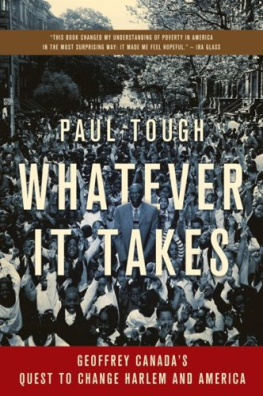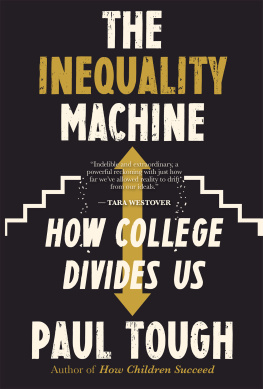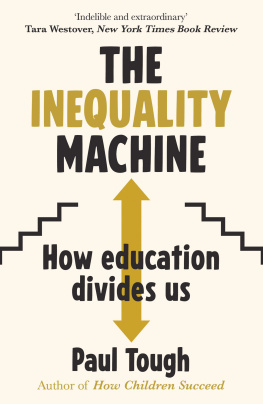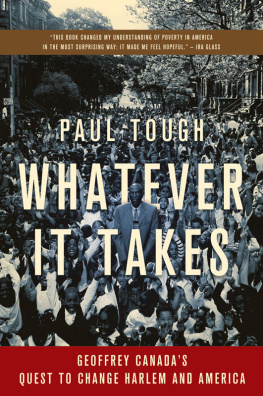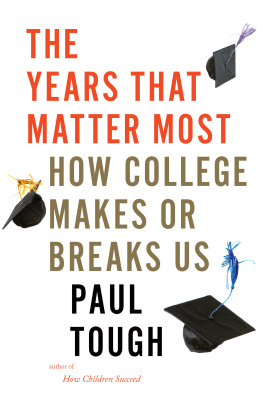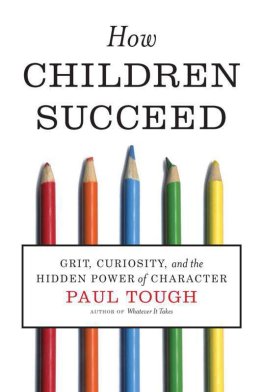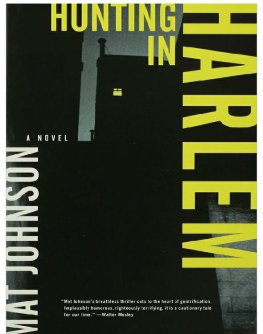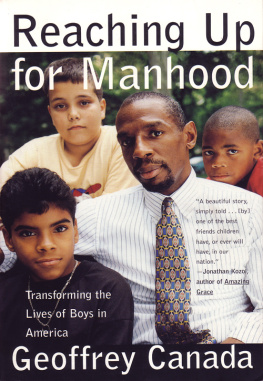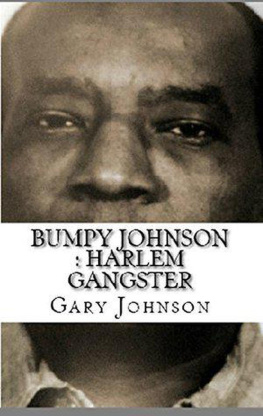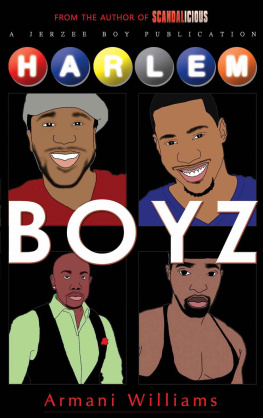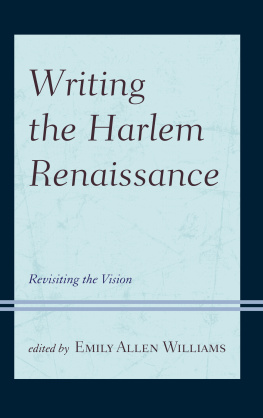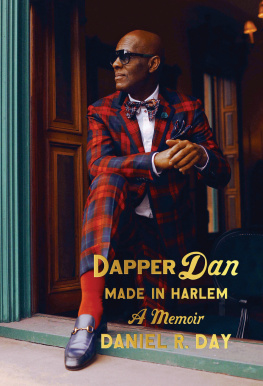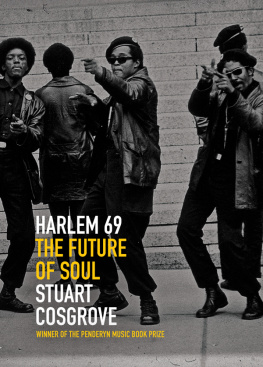
Table of Contents
Copyright 2008 by Paul Tough
Photographs copyright 2008 by Alex Tehrani
ALL RIGHTS RESERVED
For information about permissions to reproduce selectionsfrom this book, write to Permissions, Houghton Mifflin Harcourt Publishing Company,215 Park Avenue South, New York, NY 10003.
www.hmhco.com
The Library of Congress has cataloged the print edition as follows:
Tough, Paul.
Whatever it takes : Geoffrey Canadas quest to change Harlem
and America / Paul Tough.
p. cm.
Includes bibliographical references and index.
ISBN 978-0-618-56989-2
1. PovertyNew York (State)New YorkPrevention. 2. African American childrenEducationNew York (State)New York. 3. African American childrenNew York (State)New YorkSocial conditions. 4. PoorNew York (State)New YorkSocial conditions. 5. Harlem (New York, N.Y.)Economic conditions. 6. Canada, Geoffrey. I. Title.
HC 79. P 63 T 68 2008 362.74'8097471dc22 2008013303
e ISBN 978-0-547-34821-6
v3.0414
A few brief portions of this book first appeared in the New York Times Magazine.
For P. and G.
The Lottery
B Y THE TIME Geoffrey Canada arrived at the Promise Academy lottery, the auditorium was almost full. He had expected a modest turnouthe figured the rain would keep a lot of parents awaybut by 6:00 P.M. more than two hundred people had crowded into the back of the hall, and there were dozens more still streaming in the front door. Here and there, members of Canadas staff were consulting clipboards and calming anxious parents. His director of education hurried past him, shouting into her cell phone. It was April 14, 2004, a cool, wet night in Harlem. The hand-lettered sign out front of PS 242, streaked with raindrops, said Welcome to the Promise Academy Charter School Lottery, and inside, past the sign-in table set up in the schools front hallway, a tall, bull-chested young man named Jeff was handing a rose to each woman as she walked in. These are for the moms, he said with a smile. Welcome to the ceremony.
Canada, a tall, thin black man in a dark blue suit, surveyed the crowd. From what he could see, the parents taking their seats in the auditorium were the ones he had hoped to attract: typical Harlem residents, mostly African American, some Hispanic, almost all poor or working class, all struggling to one degree or another with the challenges of raising and educating children in one of New York Citys most impoverished neighborhoods. In many ways, their sons and daughters were growing up the way Canada had, four decades before, just a few miles away in the South Bronx: cut off from the American mainstream, their futures constrained by substandard schools, unstable families, and a segregated city.
Five years earlier, frustrated by Harlems seemingly intractable problems, Canada had embarked on an outsized and audacious new endeavor, a poverty-fighting project that was different from anything that had come before it. Since 1990, he had been the president of a well-respected local nonprofit organization called the Rheedlen Centers for Children and Families, which operated a handful of programs in upper Manhattan targeted at young people: afterschool drop-in centers, truancy prevention, antiviolence training for teenagers. They were decent programs, and they all did some good for the kids who were enrolled in them. But after Canada had been running them for a few years, day in and day out, his ideas about poverty started to change.
The catalyst was surprisingly simple: a waiting list. One Rheedlen afterschool program had more children who wanted to enroll than it was able to admit. So Canada chose the obvious remedy: he drew up a waiting list, and it quickly filled with the names of children who needed his help and couldnt get it. That bothered him, and it kept bothering him, and before long it had him thinking differently about his entire organization. Sure, the five hundred children who were lucky enough to be participating in one of his programs were getting help, but why those five hundred and not the five hundred on the waiting list? Or why not another five hundred altogether? For that matter, why five hundred and not five thousand? If all he was doing was picking some kids to save and letting the rest fail, what was the point?
Canada became less and less sure of what his programs really added up to. Each one was supported by a separate short-term grant, often on a contract from one city agency or another, and in order to keep the money flowing, Canada was required to demonstrate to the foundations and agencies that paid for the programs that a certain number of children had participated. But no one seemed to care whether the programs were actually working. In fact, no one seemed to have given a whole lot of thought to what, in this context, working might really mean.
Canada began to wonder what would happen if he reversed the equation. Instead of coming up with a menu of well-meaning programs and then trying to figure out what they accomplished and how they fit together, what if he started with the outcomes he wanted to achieve and then worked backward from there, changing and tweaking and overhauling programs until they actually produced the right results? When he followed this train of thought a little further, he realized that it wasnt the outcomes of individual programs that he really cared about: what mattered was the overall impact he was able to have on the children he was trying to serve. He was all too familiar with the fade-out phenomenon, where a group of needy kids are helped along by one program or another, only to return to the disappointing mean soon after the program ends. Head Start, the government-funded prekindergarten program for poor children, was the classic example. Plenty of studies had determined conclusively that graduates of Head Start entered kindergarten ahead of their inner-city peers. And plenty of studies had shown that a few years later, those same graduates had slipped back to the anemic achievement level of neighborhood kids who hadnt attended Head Start. A few years of bad schooling and bad surroundings were powerful enough to wipe out all of the programs gains.
Canada wanted to find a way off the treadmill. So he asked himself a series of questions, and gradually his thinking took shape.
Who did he want to help?
He wanted to help poor children.
What was his goal for them?
He wanted them to be able to grow into fully functioning participants in mainstream American middle-class life.
What did they need to do to accomplish that?
They had to survive adolescence, graduate from high school, get into college, and graduate from college.
And what did he have to provide in order to help them accomplish that?
Well, that was where the questions got interesting, and difficult to answer.
He concluded, first, that his efforts couldnt be as diffuse and haphazard as they had been. He would need to select a single geographical area and devote all of his energies to that one place. He would have to start intervening in childrens lives when they were young, at birth or even earlier. The support system he provided would need to be comprehensive, a continuous, linked series of programs. It wasnt enough to help out in just one part of a childs life: the project would need to combine educational, social, and medical services. And he wanted serious numbers. He wasnt interested in helping just a few kids, the ones who were already most likely to succeed, the ones whose parents had the resources and foresight to seek out aid and support for themselves and their children.
Next page
